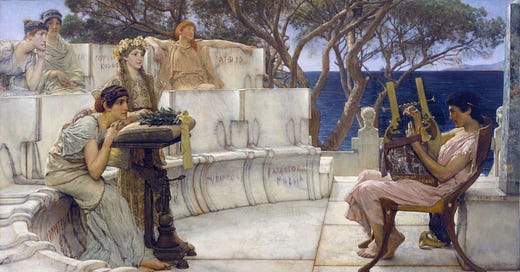Sappho was many things: brilliant poet, pioneer of the female gaze in literature, queer icon. And, looking at that list, it isn’t a surprise that she was also an absolute master of the fine art of throwing shade.
Shade has been written about a million times: the challenges of pinning it down, its roots in 80s LGBTQ ballroom culture and drag, its popularization through Ru Paul’s Drag Race. The art of shade is in the delicate balance of insulting and non-insulting elements. You want it to be clear that it’s an insult, or else the shade will totally go over everyone’s head — but, as Ru Paul tweeted in 2012, “Throwing shade takes a bit of creativity, being a bitch takes none.” Alas, the glory days of Twitter shade are now long behind us, and now everyone there is just awful, which isn’t conducive to shade.
The essential elements of shade are subaltern identity and wit, so even though Sappho pre-dates the height of shade by a few millennia, she’s got all the ingredients for a true master.
Please note that I’m interpreting shade pretty freely here. There are plenty of non-shady interpretations of these poems. Those are actually better, more grounded readings, if we’re being honest. If you want to do new historicist readings that take into account the cultural and literary milieu in which Sappho operated, you’ll probably see a lot less shade and a lot more references to archaic Greek marriage rituals. For the literary criticism nerds among us, I guess what I’m doing here is more of an extremely online queer new criticism thing. Which, now that I write it out, seems self-contradictory. But that’s fine.
What I’m saying is, if you want to read shade into the fragmentary remains of Sappho and imagine her trading barbs with Drag Race contestants… it’s definitely there. Just imagine, like the classic Key & Peele “Obama’s anger translator” recurring bit, a drag queen standing behind Sappho, acting as her shade translator. I can’t unsee that mental image now. I long for a redo of the famous Alma-Tadema painting of Sappo and Alcaeus where the woman next to her is a drag queen giving side-eye.
Poem 1
This poem is about Sappho, in the throes of a debilitating crush, calling on Aphrodite to help her out (not for the first time, it seems). She imagines Aphrodite coming to her, then dunking on her:
But you, O blessed one,
smiled in your deathless face
and asked what (now again) I have suffered and why
(now again) I am calling out
and what I want to happen most of all
in my crazy heart. Whom should I persuade (now again)
to lead you back into her love? Who, O
Sappho, is wronging you?
A masterclass already. Anne Carson’s translation (which I’m using throughout) really gives the full shady force of the repeated δηὖτε in the text — although it’s possible that the “(now again)” is just a touch heavy-handed? A simple “now” might work just as well to convey that Sappho being so completely obsessed with a new girl that she summons Aphrodite is a regular phenomenon.
But really, the true *chef’s kiss* here is that Sappho has shade thrown at her by the goddess Aphrodite, suggesting a sort of easy camaraderie between the two. What a flex! Aphrodite wouldn’t bother to appear, or throw shade, at someone beneath her notice.
Poem 5
And all the wrong he did before, loose it.
Make him a joy to his friends,
a pain to his enemies and let there exist for us
not one single further sorrow.
This poem is begging for the safe return of her brother from a sea voyage. It’s a true artist who can convey both genuine distress and longing for a lost sibling and also imply that the sibling kind of sucks. Goals.
Poem 22
]for when I look at you
]such a Hermione
]and to yellowhaired Helen I liken you
“You know who you remind me of? Hermione! No, not the Harry Potter one who rules and is the true hero of those books, the Greek myth one. Oh, you don’t remember a Hermione from myth? She was the daughter of Helen and Menelaus. I guess there really aren’t any stories about her. She shows up in Euripides’ Andromache and is a total bitch. Anyway, she probably looked sort of like her mom, the most beautiful woman on earth, so I guess what I’m really saying is that you look sort of like the much-less-famous daughter of Helen of Troy! Aren’t you flattered?”
Poem 57
what country girl seduces your wits
wearing a country dress
not knowing how to pull the cloth to her ankles?
Borderline whether this is shade or just a straight-up insult, but I think the repetition of ἀγροΐωτις/ἀγροΐωτιν (translated here as “country”) tips it over. Sort of like Mariah Carey saying “I don’t know her,” it implies that the literal only thing the speaker knows about this girl is that she has no sophistication and she’s not even going to bother to think of a second adjective.
Poem 106
outstanding as the Lesbian singer compared to those
elsewhere
Know your worth and the shade will flow.
Poem 115
Carson does a whole calligram thing with this poem:
But no amount of weird, artsy spacing can hide what real ones know to be true: that comparing a bridegroom to a slender sapling is the most basic, uninspired comparison in Sappho’s whole arsenal, and she knows it. It implies that this dude could become a huge impressive tree, maybe? I guess? Only time will tell! In the meantime, he has no real defining features that suggest a different, more evocative comparison!
Poem 120
but I am not someone who likes to wound
rather I have a quiet mind
Suuuuure you don’t, Sappho.
Poem 165
For this one, I’m going to include the Greek:
φαίνεταί ϝοι κῆνος
that man seems to himself
This is a lot like the beginning of Sappho’s most famous poem, fr. 31 (φάινεταί μοι κῆνος ἴσος θέοισιν), about a man who seems to Sappho to be equal to the gods (because he’s sitting across from her crush). I wrote about it a bit here:
Probably it is the same poem, actually, and the digamma is a result of a monk who wrote a μ so badly that it looked more like a ϝ. Whomst among us, etc. But I like to think this poem is about a mansplainer with a drastically overinflated impression of himself.
If only we had the complete, Odyssey-sized corpus of Sappho’s poems. Imagine all that glorious shade, lost to the sands of time! Yet another reason to be mad about the burning of the Great Library of Alexandria. Although the sad, hard truth about the burning of the Great Library is that although it did burn, it had already declined to a shell of its former self through lack of funding for the arts and political cronyism, two things that luckily are no longer problem today. Sigh. At least we have The Verge’s The Great Scrollback of Alexandria archiving the best tweets from the pre-Musk glory days.








I absolutely loved all of this. Thank you.